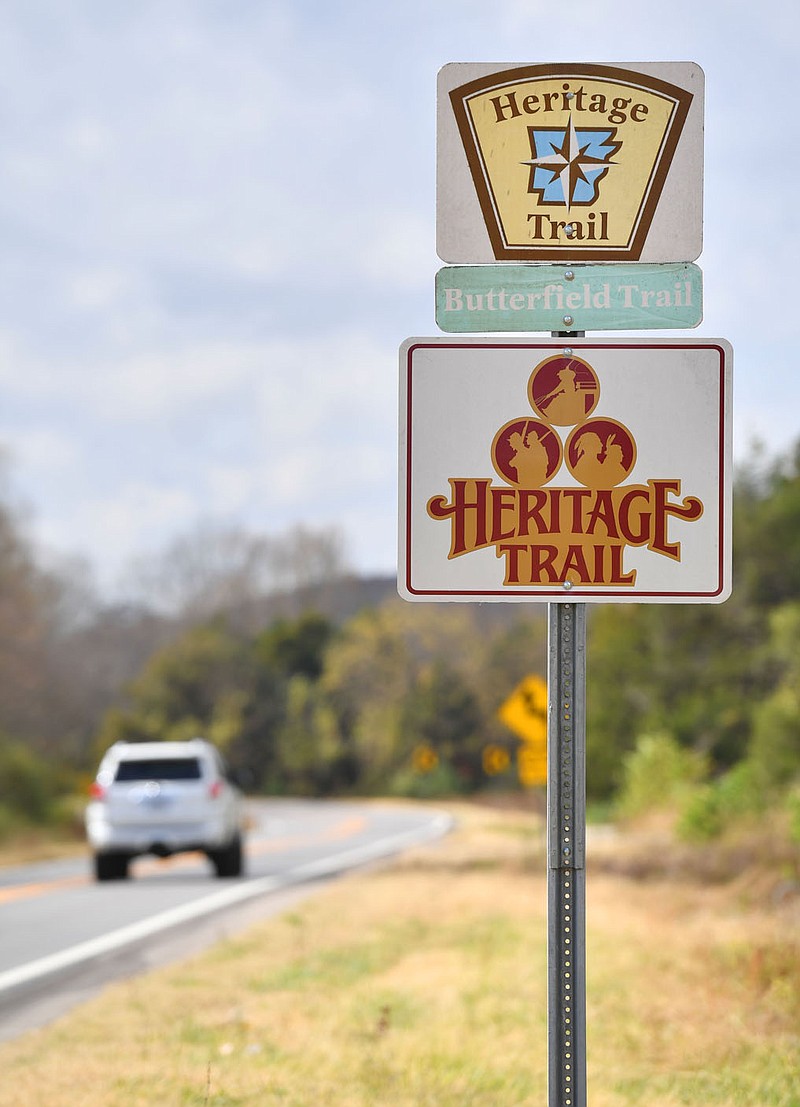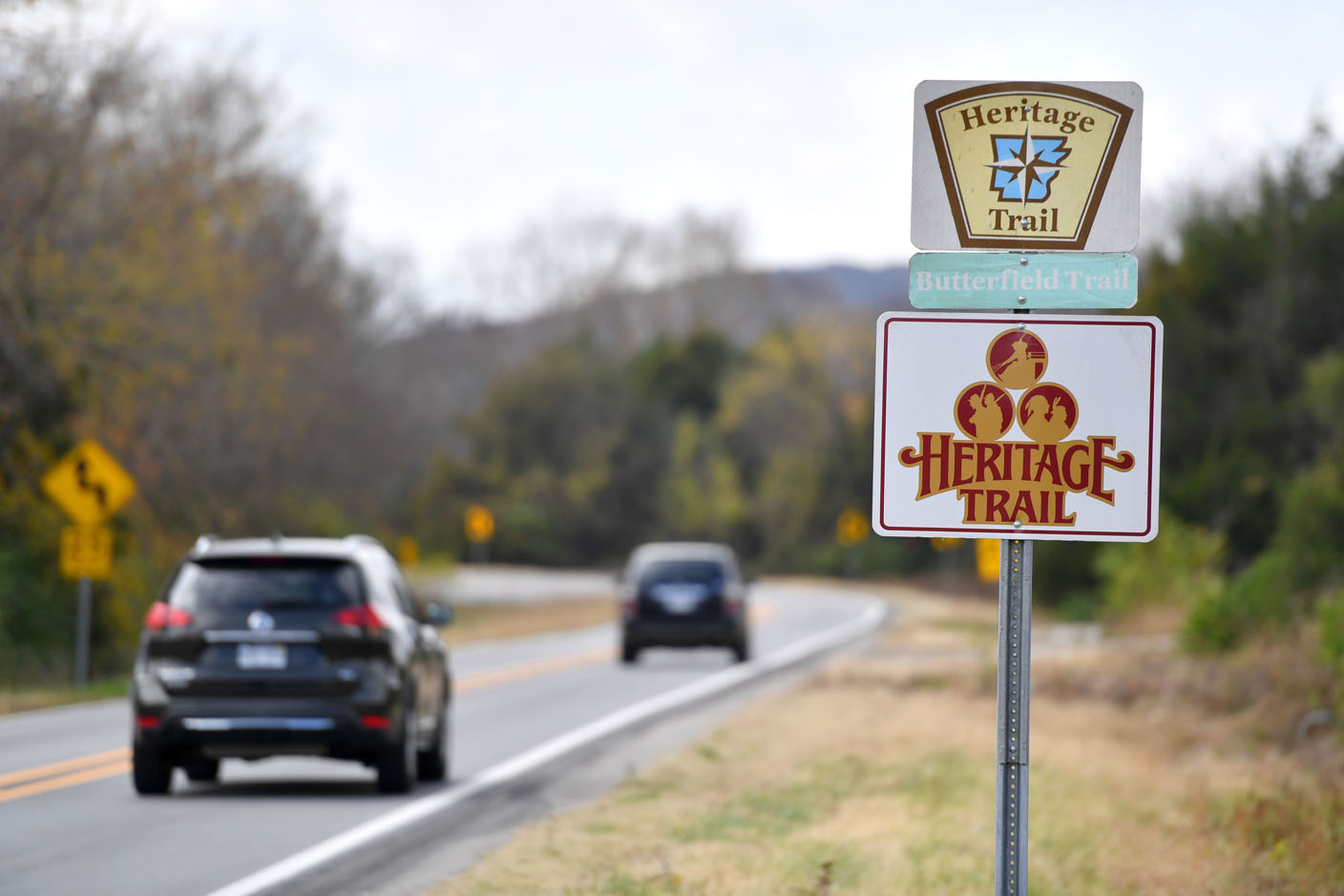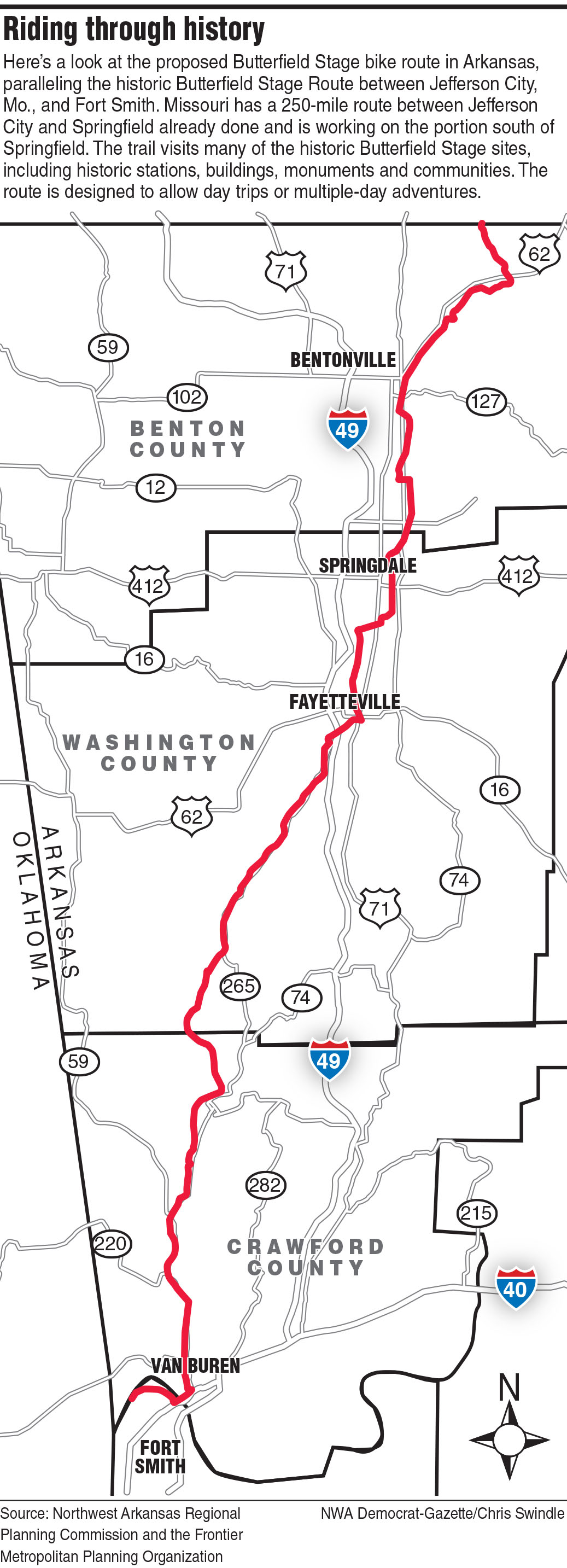FAYETTEVILLE -- What once was old is new again for the Butterfield Trail as the historic stagecoach and military route is being repurposed for cyclists in Northwest Arkansas and the River Valley.
The Northwest Arkansas Regional Planning Commission is expected to vote in December to recommend approval of a route through Washington and Benton counties that will be part of a bicycle touring route that parallels the historic Butterfield Stage Route between Jefferson City, Mo., and Fort Smith, about 500 miles in total when complete.
"It's really great to be able to ride on a designated route from Jefferson City to Fort Smith as you're passing by and utilizing a route that was used back in the 1800s," said Elizabeth Bowen, project manager with the commission. "Each of the maps we've put together will have each of those sites that you can stop and visit."
The Frontier Metropolitan Planning Organization, which serves Fort Smith and the River Valley, is expected to approve the route through Crawford and Sebastian counties, according to Reese Brewer, the group's director.
Bowen said Northwest Arkansas planners are working with Missouri officials, the Frontier planners and the Missouri Bicycle & Pedestrian Federation to adopt a route from Springfield, Mo., to Fort Smith.
"Active Transportation Committee members rode or drove the route, which the committee recommended to regional planners," she said.
The route in Missouri is mostly on well-maintained county gravel roads and multi-use trails, with a few mountain bike trail routes and paved "country road" or rural city street sections as needed for connectivity.
In Arkansas, the route is on or parallels the original route in most places. For safety, it does divert to the Northwest Arkansas Razorback Greenway through part of the metro area, Bowen said.
"We have moved off the route onto the Razorback Greenway rather than following [Arkansas] 265, where we don't have a bike lane, all the way south to Fayetteville," Bowen said. "It's just much safer in Springdale for people wanting to follow that route to just jump on the Greenway until they can get to south Fayetteville, then jump back on the original route."
Bowen has been working on the project since 2017.
"We're just now getting all the parties together and getting a route finalized," she said. "I think there were close to 20 organizations that we had to communicate with and get their approval."
The state and every city and county the route passes through had to approve the selected route, Bowen said. The decision to stay off Arkansas 265 took many months.
STARTS IN MISSOURI
Missouri has a 250-mile route between Jefferson City and Springfield and is working on the portion south of Springfield, according to Brent Hugh, executive director of the Missouri Bicycle & Pedestrian Federation. The portion from Springfield to Fort Smith will add about 250 miles. Riders will also be able to connect directly to the Katy, Rock Island and Frisco Highline Trails in Missouri.
"What you guys are doing in Arkansas is just amazing," Hugh said. "First of all, it's going to double the length; from Springdale to Fort Smith is almost another 250 miles, and the thing is with these bicycle routes, the longer it is, the farther people will travel to visit it, and the longer they will stay, so it's a double bonus."
He said the Butterfield is a great fit for Northwest Arkansas with all of the cycling attractions already available, and the Fort Smith and Van Buren area is steeped in history. Hugh said he and his wife drove the Arkansas portion during a trip to Oklahoma just to see what was possible.
"We were just wowed. This is just going to be amazing," he said. "Historically, [Fort Smith] was a major nexus of activity, the army bases and everything. That's one reason the Butterfield went through there. So really, it's a great destination."
The trail visits many historic Butterfield Stage sites along the way, including historic stations, buildings, monuments, national parks and communities.
GPS routes in Missouri also include points of interest for available camping, lodging, stores, supplies, restaurants and other practical information needed to complete a trip along the historic route.
"One of the reasons people hesitate to just head out through the hinterlands like this is, where is this road going to go?" Hugh said. "So first off, it's an entirely scoped-out route that you know you're not going to get lost."
In Missouri, a group went along the route and marked the location of every station with stone markers in the early 1900s, Hugh said.
"In Missouri you can go from stone to stone and basically visit every station that existed along the route, and what people do is get a selfie with the Butterfield stones and see if you can collect them all," he said.
Hugh said a surprising number of the original stations in Missouri have survived.
"In Warsaw, one of them is now a funeral home, another one is just somebody's house," Hugh said. "Just going along the road you'd never think that this is some 1858 stagecoach stop, but it's still there and somebody's living in it. And Arkansas even beats Missouri; some of the historical stations along the way are just amazing."
Hugh pointed to Fitzgerald Station in Springdale as a good example.
"The stable building itself is one thing, but there's a whole complex of other stuff that looked pretty authentic to me, so that's definitely one of the highlights of the trip and something you don't want to miss," Hugh said. "And of course the national parks, Pea Ridge and Wilson's Creek, amazing tie-in with all that Civil War history and all the other history along the routes."
He said many rural segments are pristine.
"You can just imagine you're back in 1858, bouncing down this dirt road in a wagon because it still looks almost the same, just historically preserved and still used like some back road, country road," he said.
CHALLENGING RIDE
Charlie Alison, a Fayetteville resident who has logged hundreds of miles of cross-country bicycle touring, said he's ridden most, if not all, of the Butterfield route in Arkansas over the years.
"One of the things is that the route through Northwest Arkansas is still able to be covered either by bicycle or motor vehicle. Most of the roads still exist," Alison said. "A lot of them are paved now, but they still exist."
Alison said a lot of historic buildings remain along the route in Northwest Arkansas.
"Springdale has the old stable that was used by the Butterfield Stage Coach Company -- the Overland Mail Company -- and coming through Fayetteville if it follows more or less the correct route, there are a good number of buildings that were standing at the time of the Butterfield Overland Mail," he said. "On Center Street, of course, there's the Walker-Stone House and the Ridge House, Headquarters House, all of those were standing at the time and still are."
Alison said there are areas between Fayetteville and Fort Smith, particularly south of Hogeye and Strickler, that haven't changed much over the years.
He added that parts of the route challenge cyclists.
"Going down from the Boston Mountains into the Lee Creek Valley, that's a pretty tough drop and a pretty tough climb if you're coming from the south; that'll test everybody," he said with a knowing chuckle. "I once accidentally rode most of it while I was a bit lost. In fact, it was my first bicycle tour."
Alison said he expects the trail designation to be a boon for tourism, especially for those who have an interest in both cycling and history.
"For the region, what it does is open up another venue for inviting tourists to visit Northwest Arkansas and, in specific, these are tourists who travel by bicycle," Alison said. "
BORDER HISTORY
Fort Smith and Van Buren have been significant because of their strategic location on the Arkansas River and what was once the nation's western border for well over 150 years, being home to military forts, Judge Isaac C. Parker's federal court and gallows and a jumping-off point for people headed west.
Brewer, the Frontier Metropolitan Planning Organization director, said the Butterfield played a huge role in shaping the area's history. On the Butterfield's maiden trip, people met in Fort Smith at 2 a.m. to hand off the mail and switch coaches and hundreds of people lined the streets, she said.
"I don't know that there's any other route that, in my view, is so significant in history," Brewer said. "It's utterly fascinating history, and we recognize that there's a lot of ecotourism developing and that many people want to go out and explore not only the Natural State, but many regional and local historic sites, and the economic generator and drivers from that are incredible."
Brewer said the biggest challenge to getting the route into Fort Smith is getting cyclists across the Midland Boulevard Bridge and the Arkansas River safely. They're studying ways to do that, but it could be expensive, she said.
The trail will then likely divert to the city's Riverfront Trail for safety reasons and the natural beauty and, ultimately, to the Fort Smith National Historic Site. The original route largely followed Midland Boulevard, went by a hotel, into the old fort then crossed the Poteau River into Oklahoma, perhaps by ferry.
There was also a ferry at Van Buren, and there's a marker on Main Street, she said. And, Van Buren has a historic downtown that is part of the route.
The National Park Service has also been supportive of the Butterfield Overland Trail connection in the sense of educating people about that history, Brewer said. The Fort Smith National Historic Site archives noted that Butterfield actually either skirted or went straight through the historic site, she said.
"It would make sense: You have supplies, the federal courthouse, all these things at that site so when you have soldiers there, it makes sense that a stagecoach would be really close," Brewer said.
NATIONAL ASPIRATIONS
The Butterfield Stage Overland Mail operated from 1858 to 1861 after John Butterfield signed a contract with the U.S. government to provide twice-a-week mail service from St. Louis to San Francisco, according to the Missouri Bicycle & Pedestrian Federation website.
The historic Butterfield Overland Stage route was one of the major intracontinental routes across North America, in the same class as the Oregon Trail, California Trail and Santa Fe Trail. At over 2,500 miles, the route was created to regularly carry passengers and mail between the eastern United States and the newly created state of California.
Extending the Butterfield along its original route all the way to the West Coast is another goal, according to Bowen, Brewer and Hugh.
"That's the ultimate goal because the part through Oklahoma -- we had some people do some early scoping -- Oklahoma and Texas looked amazing and very possible," Hugh said. "Someone has actually ridden the part from California back through Arizona, the Phoenix area, and reported that was great."
Brewer said that designation is key to getting future federal money for the trail. Legislation to add the Butterfield to the National Historic Trails system is pending in Congress.
Several states are showing interest in getting involved with extending the trail, Bowen said.
"We have had four-state communication about it," Bowen said. "Arkansas and Missouri, we're finishing ours up. Oklahoma and Arizona were on a call with us, and they are definitely interested in continuing this route to try and get to San Francisco."


